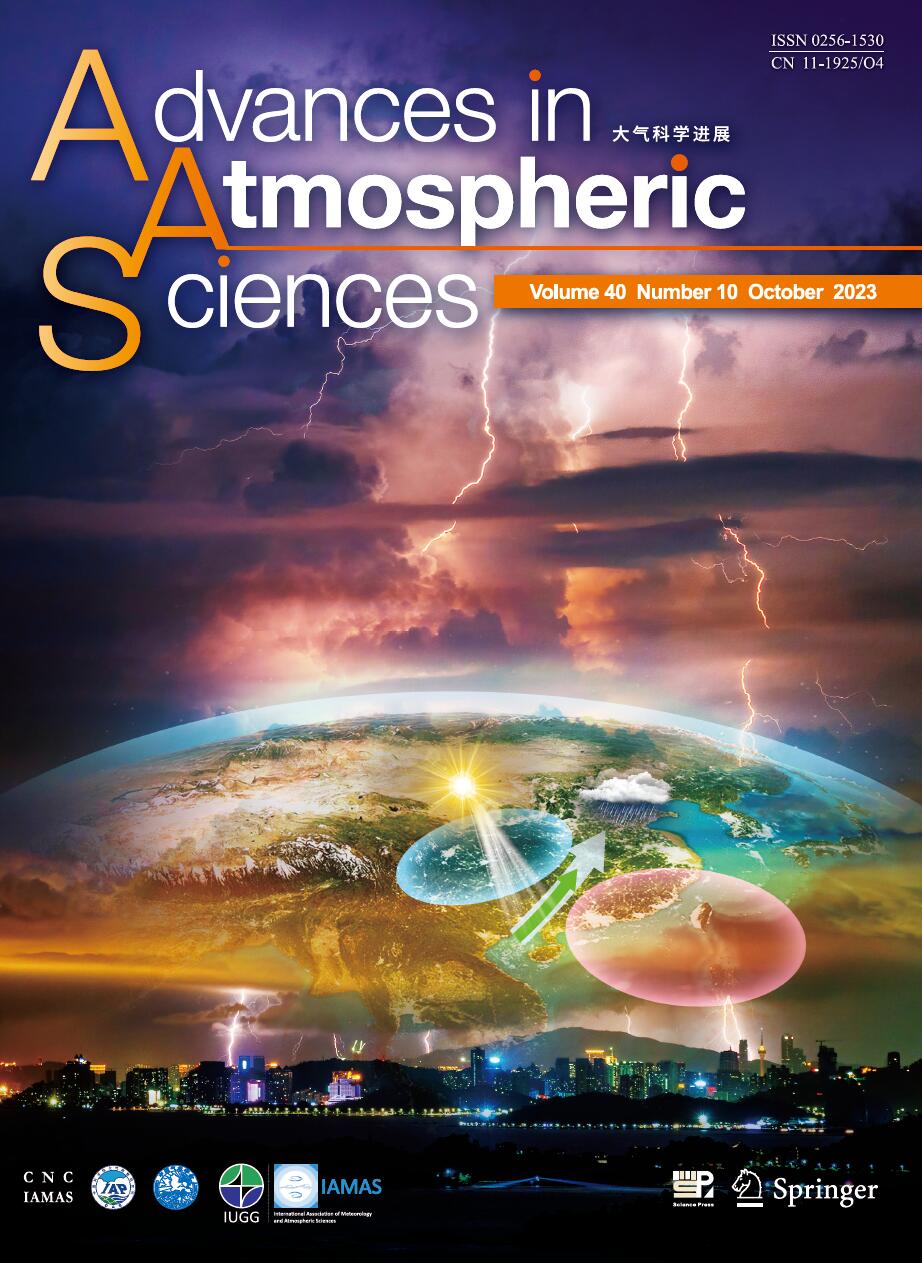| [1] |
D. R. Johnson, Zhuojian Yuan,
1998: The Development and Initial Tests of an Atmospheric Model Based on a Vertical Coordinate with a Smooth Transition from Terrain Following to Isentropic Coordinates, ADVANCES IN ATMOSPHERIC SCIENCES, 15, 283-299.
doi: 10.1007/s00376-998-0001-0
|
| [2] |
Zuohao Cao,
1999: Dynamics of Absolute Vorticity in the Boussinesq Fluid, ADVANCES IN ATMOSPHERIC SCIENCES, 16, 482-486.
doi: 10.1007/s00376-999-0025-0
|
| [3] |
Chao LIU, Li FU, Dan YANG, David R. MILLER, Junming WANG,
2020: Non-Gaussian Lagrangian Stochastic Model for Wind Field Simulation in the Surface Layer, ADVANCES IN ATMOSPHERIC SCIENCES, 37, 90-104.
doi: 10.1007/s00376-019-9052-7
|
| [4] |
LI Xiaohan, PENG Xindong, LI Xingliang,
2015: An Improved Dynamic Core for a Non-hydrostatic Model System on the Yin-Yang Grid, ADVANCES IN ATMOSPHERIC SCIENCES, 32, 648-658.
doi: 10.1007/s00376-014-4120-5
|
| [5] |
Xun ZHU,
2003: Parameterization of the Non-Local Thermodynamic Equilibrium Source Function with Chemical Production by an Equivalent Two-Level Model, ADVANCES IN ATMOSPHERIC SCIENCES, 20, 487-495.
doi: 10.1007/BF02915493
|
| [6] |
Xun Zhu,
1989: A Parameterization of Cooling Rate Calculation under the Non-LTE Condition: Multi-Level Model, ADVANCES IN ATMOSPHERIC SCIENCES, 6, 403-413.
doi: 10.1007/BF02659075
|
| [7] |
Yifan ZHAO, Xindong PENG, Xiaohan LI, Siyuan CHEN,
2024: Improved Diurnal Cycle of Precipitation on Land in a Global Non-Hydrostatic Model Using a Revised NSAS Deep Convective Scheme, ADVANCES IN ATMOSPHERIC SCIENCES.
doi: 10.1007/s00376-023-3121-7
|
| [8] |
Kong Fanyou, Qin Yu,
1993: The Vertical Transport of Air Pollutants by Convective Clouds. Part I: A Non-Reactive Cloud Transport Model, ADVANCES IN ATMOSPHERIC SCIENCES, 10, 415-427.
doi: 10.1007/BF02656966
|
| [9] |
Jiang Weimei, Wang Xuemei,
1996: A 2-D Non-local Closure Model for Atmospheric Boundary Layer Simulations, ADVANCES IN ATMOSPHERIC SCIENCES, 13, 169-182.
doi: 10.1007/BF02656860
|
| [10] |
B. Parthasarathy, K. Rupa Kumar, A. A. Munot,
1992: Surface Pressure and Summer Monsoon Rainfall over India, ADVANCES IN ATMOSPHERIC SCIENCES, 9, 359-366.
doi: 10.1007/BF02656946
|
| [11] |
Ren Shuzhan,
1994: Symmetric Stability of Rotation and Boussinesq Fluid in Bounded Domain by Using Normal Mode Method, ADVANCES IN ATMOSPHERIC SCIENCES, 11, 291-295.
doi: 10.1007/BF02658148
|
| [12] |
DAI Tie, SHI Guangyu, Teruyuki NAKAJIMA,
2015: Analysis and Evaluation of the Global Aerosol Optical Properties Simulated by an Online Aerosol-coupled Non-hydrostatic Icosahedral Atmospheric Model, ADVANCES IN ATMOSPHERIC SCIENCES, 32, 743-758.
doi: 10.1007/s00376-014-4098-z
|
| [13] |
Jianjun Xu, Johnny C. L. Chan,
2002: Interannual and Interdecadal Variability of Winter Precipitation over China in Relation to Global Sea Level Pressure Anomalies, ADVANCES IN ATMOSPHERIC SCIENCES, 19, 914-926.
doi: 10.1007/s00376-002-0055-3
|
| [14] |
HUANG Yanyan, XUE Jishan, WAN Qilin, CHEN Zitong, DING Weiyu, ZHANG Chengzhong,
2013: Improvement of the Surface Pressure Operator in GRAPES and Its Application in Precipitation Forecasting in South China, ADVANCES IN ATMOSPHERIC SCIENCES, 30, 354-366.
doi: 10.1007/s00376-012-1270-1
|
| [15] |
WANG Panxing, Julian X. L. WANG, ZHI Hai, WANG Yukun, SUN Xiaojuan,
2012: Circulation Indices of the Aleutian Low Pressure System: Definitions and Relationships to Climate Anomalies in the Northern Hemisphere, ADVANCES IN ATMOSPHERIC SCIENCES, 29, 1111-1118.
doi: 10.1007/s00376-012-1196-7
|
| [16] |
H. M. HASANEAN, H. Abdel BASSET, M. A. A. HUSSEIN,
2015: On the Relationship between Climatic Variables and Pressure Systems over Saudi Arabia in the Winter Season, ADVANCES IN ATMOSPHERIC SCIENCES, 32, 690-703.
doi: 10.1007/s00376-014-4149-5
|
| [17] |
Lesi WEI, Huazhe SHANG, Jian XU, Chong SHI, Gegen TANA, Kefu CHAO, Shanhu BAO, Liangfu CHEN, Husi LETU,
2024: Cloud Top Pressure Retrieval Using Polarized and Oxygen A-band Measurements from GF5 and PARASOL Satellites, ADVANCES IN ATMOSPHERIC SCIENCES, 41, 680-700.
doi: 10.1007/s00376-023-2382-5
|
| [18] |
Shaoying LI, Jun PENG, Weimin ZHANG, Jianping WU, Qiang YAO, Xiangrong YANG, Tengling LUO,
2023: Effects of a Dry-Mass Conserving Dynamical Core on the Simulation of Tropical Cyclones, ADVANCES IN ATMOSPHERIC SCIENCES, 40, 464-482.
doi: 10.1007/s00376-022-2085-3
|
| [19] |
Lin Wantao, Ji Zhongzhen, Wang Bin,
2002: A Comparative Analysis of Computational Stability for Linear and Non-Linear Evolution Equations, ADVANCES IN ATMOSPHERIC SCIENCES, 19, 699-704.
doi: 10.1007/s00376-002-0009-9
|
| [20] |
Yuqiang SONG, Hongnian LIU, Xueyuan WANG, Ning ZHANG, Jianning SUN,
2016: Numerical Simulation of the Impact of Urban Non-uniformity on Precipitation, ADVANCES IN ATMOSPHERIC SCIENCES, 33, 783-793.
doi: 10.1007/s00376-016-5042-1
|















 AAS Website
AAS Website 
 AAS WeChat
AAS WeChat 
 DownLoad:
DownLoad: